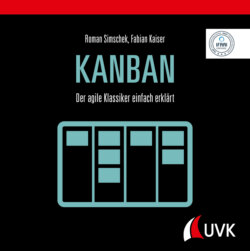Читать книгу Kanban - Roman Simschek - Страница 22
На сайте Литреса книга снята с продажи.
Die 12 Prinzipien des Agilen Manifests
ОглавлениеDie 12 Prinzipien im Agilen Manifest konkretisieren die Botschaften aus den vier Wertepaaren. Die in der Grafik dargestellten Prinzipien wurden dem Agilen Manifest entnommen und so dargestellt, wie du diese auch im Netz finden kannst. Wir wollen die Prinzipien an dieser Stelle unkommentiert lassen. Sie stehen so, wie sie formuliert sind, für sich und bedürfen aus unserer Sicht keiner weiteren Konkretisierung oder Interpretation.
Kundenzufriedenheit
Unsere höchste Priorität ist es, den Kunden durch frühe und kontinuierliche Auslieferung wertvoller Software zufrieden zu stellen.
Anforderungsänderungen als Wettbewerbsvorteil
Heiße Anforderungsänderungen selbst spät in der Entwicklung willkommen! Agile Prozesse nutzen Veränderungen zum Wettbewerbsvorteil des Kunden.
Regelmäßige Auslieferung in kurzen Zeitspannen
Liefere funktionierende Software regelmäßig innerhalb weniger Wochen oder Monate und bevorzuge dabei die kürzere Zeitspanne!
Tägliche Zusammenarbeit im Projekt
Fachexperten und Entwickler müssen während des Projektes täglich zusammenarbeiten.
Teams aus motivierten Individuen
Errichte Projekte rund um motivierte Individuen. Gib ihnen das Umfeld und die Unterstützung, die sie benötigen, und vertraue darauf, dass sie die Aufgabe erledigen!
Kommunikation von Angesicht zu Angesicht
Die effizienteste und effektivste Methode, Informationen an und innerhalb eines Entwicklungsteams zu übermitteln, ist im Gespräch von Angesicht zu Angesicht.
Funktionierende Software
Funktionierende Software ist das wichtigste Fortschrittsmaß.
Nachhaltigkeit
Agile Prozesse fördern nachhaltige Entwicklung. Die Auftraggeber, Entwickler und Benutzer sollten ein gleichmäßiges Tempo auf unbegrenzte Zeit halten können.
Technische Exzellenz
Ständiges Augenmerk auf technische Exzellenz und gutes Design fördert Agilität.
Einfachheit
Einfachheit: die Kunst, die Menge nicht getaner Arbeit zu maximieren, ist essenziell.
Selbstorganisierende Teams
Die besten Architekturen, Anforderungen und Entwürfe entstehen durch selbstorganisierte Teams.
Regelmäßige Reflektion und Anpassung
In regelmäßigen Abständen reflektiert das Team, wie es effektiver werden kann, und passt sein Verhalten entsprechend an.
Abbildung 5: Prinzipien des Agilen Manifests
Übungsfragen
[1]Why is Kanban so flexible?
Kanban prescribes exactly what has to be implemented.
You do not have to implement anything.
You must implement at least several rules.
Kanban does not prescribe what has to be implemented.
[2]How does Kanban work when introducing changes?
Kanban uses a revolutionary approach.
Kanban uses an evolutionary approach.
Kanban uses both of the above.
All of the above answers are incorrect.
[3]What is the advantage of using Kanban?
Kanban focuses on the team.
Kanban is a method used by top management.
Kanban can only be used in software development.
Kanban is scalable and can be applied throughout the organization.
[4]The Agile Manifesto …
Has been developed by various representatives from the software development industry.
Comprises pairs of contrasting values.
Comprises pairs of values, one of which is considered more important than the other.
All of the above answers are correct.
[5]Important pairs of values according to the Agile Manifest are …
Working software.
Individuals and interaction.
Cooperation with the customer.
Reaction to change.
All of the above answers are correct.
[6]How many agile principles are there?
7
14
12
3
[7]What is the first agile principle?
Customer satisfaction.
Daily collaboration.
Teams of motivated individuals.
Sustainability.
[8]Team members should …
Work together on a daily basis.
Be highly motivated.
Communicate face to face.
Answers 2 and 3 are correct.
[9]What is the most important measure of progress?
Sustainability.
Technical excellence.
Simplicity.
Working software.
[10]How should software be delivered according to the Agile Manifesto?
In long intervals.
In short intervals.
Regularly.
Answers 2 and 3 are correct.
[11]How should teams work together?
Self-organized.
Separate from each other.
The work must be specified in detail.
None of the above answers are correct.
[12]Kanban offers the possibility to …
React quickly and flexibly to customer needs.
Incremental further development of existing processes.
Change the organization.
All of the above answers are correct.
[13]Why is Kanban so successful?
Kanban pursues continuous improvement.
Kanban is adaptable.
Kanban is agile.
All of the above answers are correct.
[14]Is Kanban agile?
Kanban is not a classical agile method.
Kanban is agile.
Kanban is a mixture of classical an agile methods.
Kanban is a method to work flow-based.
